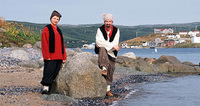Named for the colour of the cliffs along the shoreline, Red Bay is the best preserved of the more than one dozen 16th century Basque whaling stations that dotted the coast from Labrador to Quebec and the Strait of Belle Isle. The bay is the site of several sunken 16th century galleons as well as whaling vessels, and is considered one of the most important underwater archeological sites in the Americas. It is a Parks Canada National Historic Site because of the numerous well-preserved cultural resources related to early whaling, fur trading, as well as the legacy of ship design and innovation, including the chalupa.
On Saddle Island in Red Bay, the presence of 60 graves in the cemetery, many with more than one skeleton per grave, speak of the hazards and multiple deaths associated with whaling.
The small community with a population of approximately 260 people is charming to visit. Iceberg viewing is a popular tourist attraction, as are hiking the rugged coastline, whale watching and exploring archeological sites. There is a visitor centre and historical interpretation centre.

This museum was built in 1978 with the goal of highlighting the local way of life over the last one hundred...

Right and bowhead whales, once plentiful in the waters of coastal Labrador, attracted whalers from the Basque country (northern Spain...